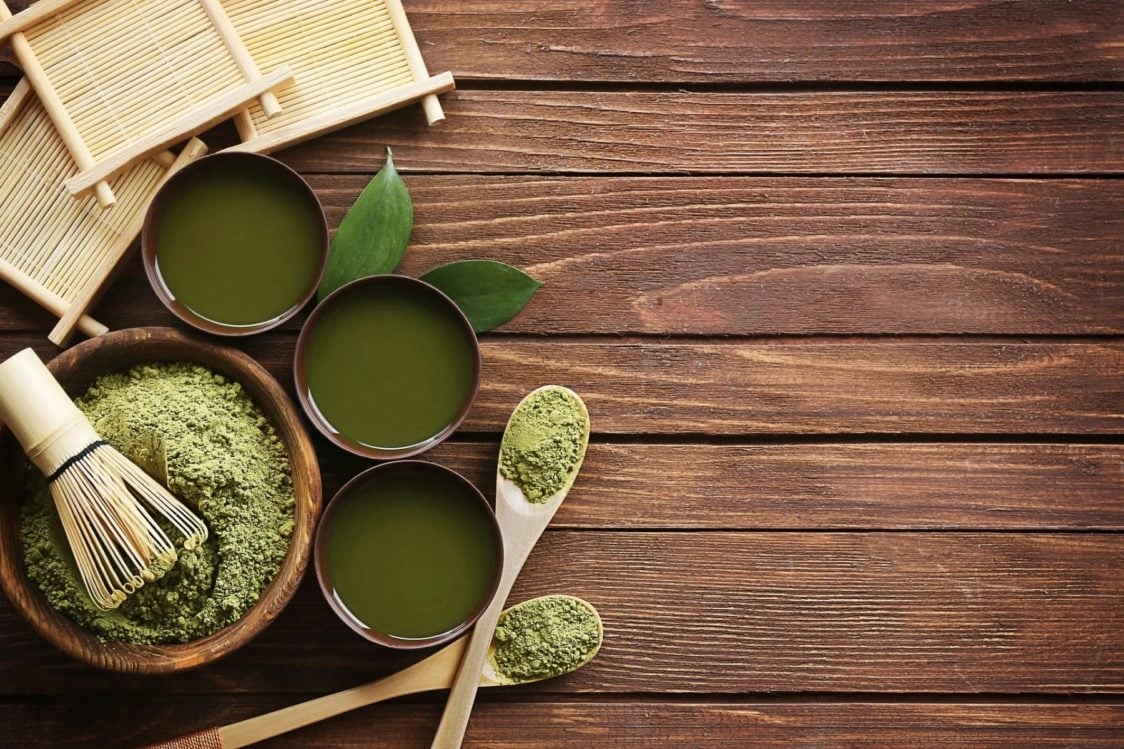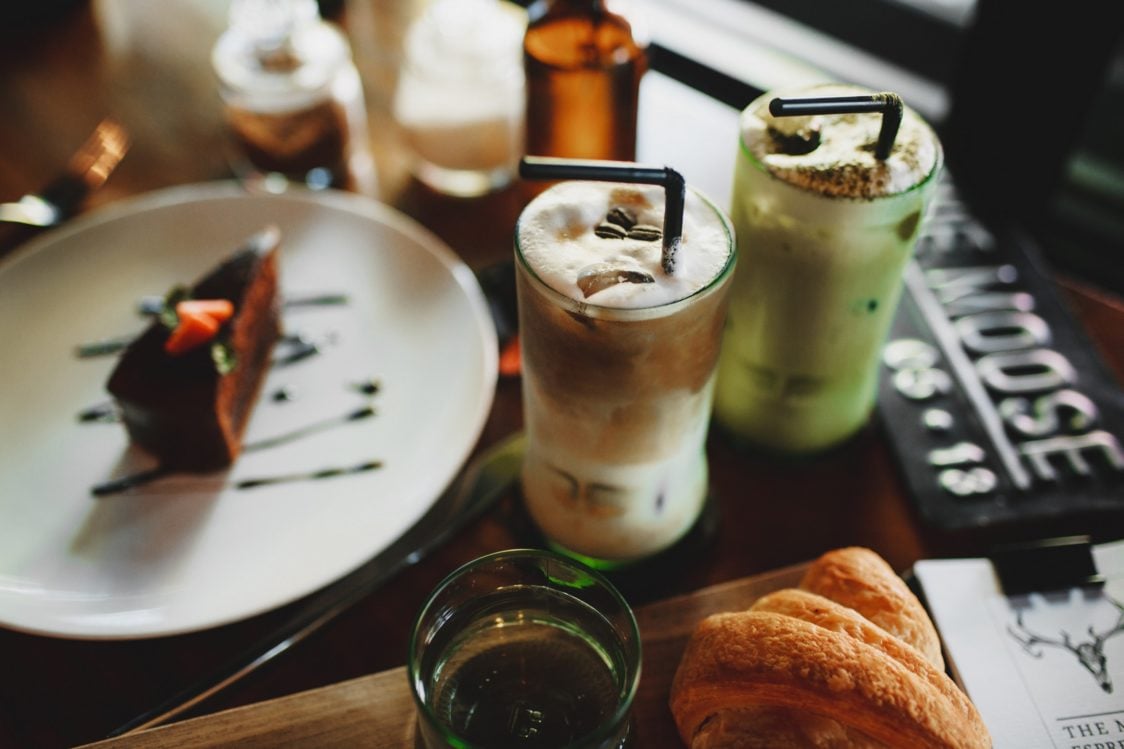Table of Contents
Do you know matcha tea – an exceptional type of green tea, the drinking of which is associated with a special ceremony in Japan? The tradition of drinking matcha tea has been known in China and Japan for centuries. Read about tea, its benefits and the possibilities of using this green miracle.
Matcha green tea
The history of matcha tea is several centuries old, and the word matcha itself is composed of two Japanese words – mat– in the sense of rubbing or painting and cha, which means tea. The tradition of preparing this tea is long and associated with Buddhism, from the whole history it is certainly appropriate to mention the name Eisai. Zen monk Eisai lived in the 12th century and brought matcha tea seeds to Japan from a study stay in China. The powdered form of tea was used in monasteries (Chinese Chan monasteries) in China because they already knew its healing effects. In addition to introducing the application of tea into his own practice, Eisai also wrote a book on the health benefits of drinking tea called Kissa Yōjōki, which we can translate as Drinking Tea for Health. Matcha is very popular nowadays and it is interesting that while the popularity of matcha tea is growing in the Western world, it is declining in Japan. In any case, it is great that the type of tea that has a long tradition in China and Japan also finds its place in our culture. [1] [2]
Matcha tea is made from the plant Camellia sinensis, for which we use the local name Chinese Tea Plant. That’s right, matcha and classic green tea come from the same plant, but matcha tea is different. The cultivation of the tea tree dates back to ancient China, where it was discovered almost 5,000 years ago by ruler Shen Nung. Even, today one of the most widely used plants, it has been considered a valuable medicine for centuries and available only to a small part of society. The cultivation of matcha tea differs from other types of green tea in that its bushes are protected from sunlight for 20-30 days before harvest. If we talk about the process of producing this type of tea, the term “matcha” is not exact. The name “matcha” is used for the final ground product, the raw material before the final grinding is called Tencha. [3] [4] [5]
Are you interested in information on matcha tea, but have you found that you want to know more about green tea itself? All the necessary facts are in the article – 8 positive effects of green tea on the health of athletes.

Important components of Matcha tea
Matcha is an exceptional tea for its health benefits, so it is important to know its composition. From the point of view of basic nutrients, matcha tea can be considered a source of protein, vitamin A and iron [6]:
| Energy value | 300 kcal (1 256 kJ) |
| Protein | 50 g |
| Cabrohydrates | 0 g |
| Fats | 0 g |
| Vitamin A | 5 000 IU |
| Iron | 18 mg |
Matcha tea is especially sought after for its high content of ingredients with antioxidant effects, such as flavonoids, polyphenols, vitamin C. The term “polyphenols” covers several compounds, including flavanediols, flavonols or phenolic acids. Thanks to sun protection, the plant can produce bioactive components, such as L-theanine or chlorophyll. Matcha tea is considered to be the product of the highest quality and the most aromatic green tea. Its “umami” taste is caused by a high content of caffeine and theanine, combined with a low content of catechin, which results in a higher content of ingredients that are responsible for the taste. The bitter taste of other types of green tea is enhanced by catechins and the fact that they are grown all the time in the sun. [7]
You might be interested in these products:
Health benefits of matcha tea
Improves concentration and brain activity
Are you looking for a stimulant, but want to take a break from coffee? Matcha tea can be a suitable alternative for better stimulation of the body. The combination of caffeine and L-theanine in matcha tea is exceptional, and thanks to caffeine, it has an encouraging and at the same time calming effect for its theanine content. The result of the combination is a state of “calm attention”, which is an advantage, because you too may know the states of restlessness that can be caused by excessive coffee drinking. L-theanine is a non-essential amino acid that can affect certain chemicals in the brain, such as dopamine or serotonin. However, the results of further research point to the fact that matcha can also improve reaction time, attention and memory. In addition, compared to green tea, matcha tea has a higher caffeine content. You will find up to 35 mg of caffeine in half a teaspoon of powder. Therefore, if you need to improve your attention and wake up for better performance, but you do not like coffee, try this tea. [8] [9] [11]

It has antioxidant effects
Thanks to the content of catechins, matcha tea is an interesting fighter against free radicals that damage cells in the body and cause chronic diseases. Compared to the tea called China Green Tips, matcha tea contains up to 137 times more specific catechin (EGCG). In addition, its value is at least 3 times higher than the highest value in the literature for other types of green teas. The presence of compounds with an antioxidant effect is a consequence of the traditional method of cultivating matcha tea. [7] [9] [16]
For all catechins in matcha green tea, mention should be made, for example, of epigallocatechin gallate (EGCG). This catechin has been studied in several animal and human studies for its potential anti-cancer effects. According to some research, epigallocatechin gallate could prevent the spread of cancer in the body. Catechins and polyphenols in tea are effective in trapping reactive oxygen species. However, they also indirectly act as antioxidants for their effect on enzyme activity and transcription factors. [8] [12]

Supports heart function and weight loss
Matcha is essentially a type of green tea, which is why its effect on heart function is often mentioned. There is no scientific evidence for the effect of matcha tea on heart disease, but there are studies that suggest a reduced risk of heart disease associated with higher doses of green tea. Green tea lowers triglyceride and LDL cholesterol levels, and also prevents the oxidation of LDL cholesterol, which can protect against heart disease. Green tea is generally known for its support of fat burning and is even available in a form of supplement. Several scientific studies confirm that green tea is useful in burning fat and reducing weight. If you are already a fan of green tea and this feature has proven itself in your body, try the alternative in the form of matcha tea. [8] [9]

Preparation of matcha tea
Tea making is considered part of their culture in Japan, and Chanoyu is proof of that. This is the name for the matcha tea preparation ceremony, which can be translated as a method of tea. In ancient times, it was a leisure activity of warriors, but today it is one of the prominent symbols of Japanese culture. [10]
Matcha tea can be prepared in 3 types of consistency [3]:
- Standard– mix 1 tea spoon of tea powder with 59 ml of hot water
- Usucha – mix ½ tea spoon with 89 – 118 ml of hot water
- Koicha – used during the Japanese ceremony, mix 2 tea spoons with 30 ml of hot water.
The traditional preparation of matcha tea is also associated with special aids that have their own special names. If you are a fan of Japanese culture and want to take tea drinking to the next level, you can buy these 9 tools for making matcha tea [10]:

- Tea container (Cha-ire / Natsume) – a box for storing tea, often used during ceremonies. It can be made of wood, bamboo, paper or plastic and is decorated and made by hand.
- Tea bowl (Chawan) – usually a ceramic bowl that is used to drink tea. Interestingly, it is not intended for hot or boiling liquids.
- Whisk (Chasen) – a special whisk designed for mixing powder, water and air. In addition to thorough mixing, its task is also proper oxygenation.
- Tea spoon (Chashaku) – bamboo spoon is designed for measuring and inserting matcha powder into bowls.
- Portable kettle (Furo) – a smaller kettle used when the fire is not available.
- Kettle lid (Futa) – used to keep warm water before it is removed from the iron pot (Kama).
- Iron pot (Kama / Chanoyugama) – a pot made of cast iron, which is used exclusively for boiling water.
- Waste water bowl (Kensui) – has a cylindrical shape and can be made of various materials. It is used in tea ceremonies and the use of other types of waste bowls is considered rude by the Japanese, especially in front of a guest.
- Drawstring bag (Shifuku) – used to store tea utensils, traditionally made of silk and can be patterned.
Use of matcha powder
In the first place, you can prepare a drink from the powder according to your own taste or the types of consistency that we present in the article. However, this is by no means the only way to use it, we have found some tips for you to incorporate matcha tea [8] [13] [14]:
- Ingredient for oatmeal – whether you make porridge or muesli in the morning, add matcha tea to the mixture. It will pleasantly color your breakfast and you will easily receive nutrients, which matcha contains.
- Ingredient for smoothie – You can add matcha into many various meals, but also drinks, such as a healthy smoothie. It will make your nutritious drink exceptionally colorfull and tasty.
- Ingredients for pastries and cakes – there are no limits to creativity, you can add matcha tea to pancakes, muffins or other desserts.
- Prepare a matcha latte – put 1 tea spoon of tea, 1 tea spoon of honey in a cup and pour 1 table spoon of boiling water. Heat and steam the milk, and pour into the mixture.
There are many options for using matcha powder and it depends on your creativity and taste. You can also add it to salad dressings, to granola, popcorn or make matcha popsicles. [8] [13]

Side effects of matcha tea
Matcha tea is generally considered safe, but you should definitely not overdo it. According to the NIH (National Institutes of Health), one should not exceed 5 cups of green tea a day, but with matcha tea, the number is lower because it is a powdered leaf. Matcha contains caffeine as well as green tea, the increased consumption of which can cause side effects such as insomnia, headaches, diarrhea or irritability. If you are concerned about using matcha tea for your medical condition, it is better to consult your doctor about using it. Consumption of matcha tea should be avoided by children, but also by pregnant and breastfeeding women. When consuming matcha powder, always keep in mind that it is green tea, and therefore it applies here, all in moderation. [15]
Matcha is a tea containing ingredients that have a positive effect on human health. Its benefits are not just for tea fans, you can add powder in many foods or drinks. We believe that you have learned everything you need about matcha tea. Do you want this information to reach your friends? Feel free to support the article by sharing.
[1] Matcha noun – https://www.merriam-webster.com/dictionary/matcha#h1
[2] Tyas Sōsen - Matcha – An Initial Encounter – https://specialtyteaalliance.org/world-of-tea/matcha-introduction/
[3] Adda Bjarnadottir - Matcha — Even More Powerful Than Regular Green Tea? – https://www.healthline.com/nutrition/matcha-green-tea
[4] Matcha vs. Green Tea: What Is the Difference? – https://the.republicoftea.com/library/types-of-tea/matcha-vs-green-tea-what-is-the-difference/
[5] Tyas Sōsen - Matcha – Cultivation – https://specialtyteaalliance.org/world-of-tea/matcha-cultivation/
[6] Matcha Green Tea Powder – https://nutritiondata.self.com/facts/custom/2190562/2
[7] Karolina Jakubczyk, Joanna Kochman, Aleksandra Kwiatkowska, Justyna Kałduńska, Karolina Dec, Dorota Kawczuga, Katarzyna Janda - Antioxidant Properties and Nutritional Composition of Matcha Green Tea – https://www.mdpi.com/2304-8158/9/4/483/htm
[8] Jillian Kubala - Is matcha good for you, and how can you use it? – https://www.medicalnewstoday.com/articles/305289
[9] Rachael Link - 7 Proven Ways Matcha Tea Improves Your Health – https://www.healthline.com/nutrition/7-benefits-of-matcha-tea
[10] Team Matcha Kari - Chanoyu, a Japanese Matcha Tea Ceremony – https://worldteanews.com/tea-industry-news-and-features/chanoyu-a-japanese-matcha-tea-ceremony
[11] Claire Sissons - Does L-theanine have health benefits? – https://www.medicalnewstoday.com/articles/324120
[12] Jane V Higdon , Balz Frei - Tea Catechins and Polyphenols: Health Effects, Metabolism, and Antioxidant Functions – https://pubmed.ncbi.nlm.nih.gov/12587987/
[13] UHN STAFF - Matcha Tea Benefits: 7 Tips for How to Use Matcha Powder – https://universityhealthnews.com/daily/nutrition/matcha-tea-benefits-7-tips-for-how-to-use-matcha-powder-for-better-health/
[14] Sophie Godwin - Matcha latte – https://www.bbcgoodfood.com/recipes/matcha-latte
[15] Cathy Wong - Matcha: Benefits and Possible Side Effects – https://www.verywellfit.com/matcha-what-should-i-know-about-it-89227
[16] David J Weiss, Christopher R Anderton - Determination of Catechins in Matcha Green Tea by Micellar Electrokinetic Chromatography – https://pubmed.ncbi.nlm.nih.gov/14518774/


Add a comment